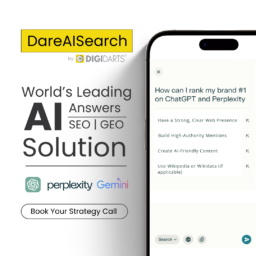
If you’ve ever tried using ChatGPT, Gemini, or Perplexity to generate a bibliography, you know the struggle. The output looks fine at first glance, but then you spot a missing DOI (Digital Object Identifier), a misplaced comma, or worse, a completely fabricated reference. Frustrating, right?
So why does this happen? And more importantly, how can you make AI work for your academic and professional needs? The answer lies in AI prompt engineering, the art of giving structured, precise instructions that guide AI tools like ChatGPT, Gemini, or Claude to deliver exactly what you need.
Here at Digidarts, India’s pioneering best performance marketing agency, we believe mastering prompt engineering is a critical skill, just like learning how to use Google effectively once was. Think of it as your toolkit to unlock accuracy, efficiency, and consistency in how you use AI.
What Prompt Engineering Really Means
Think of prompt engineering as giving instructions to a highly intelligent but overly literal assistant. The assistant knows everything, but if you’re vague, you’ll get vague or wrong results. That’s how large language models (LLMs) like ChatGPT or Perplexity work.
Prompt engineering, thus, is the process of crafting those instructions so well that the AI has no choice but to give you the exact result you’re looking for.
For something like citations, precision matters. A wrong year or punctuation mark can weaken your credibility. That’s why learning to guide AI step by step is the difference between a flawless bibliography and a confusing mess.
Why You Should Care About Prompt Engineering
Here’s the truth: AI is powerful, but it isn’t flawless. If you simply ask it to “cite a webpage,” it may try to fill in missing details on its own—leading to hallucinations or entirely inaccurate references.
That’s where prompt engineering makes a difference. By giving AI structured inputs, like the author’s name, publication year, DOI, or page numbers, you eliminate the guesswork and get accurate citations in your preferred style, whether APA, MLA, or Chicago.
The same principle applies to marketing. With the right prompts, brands can build sharper SEO strategies, uncover campaign insights, and harness AI-driven analytics.
DareAISearch is built on these very principles. As an advanced GEO tool, it ensures outputs are precise, reliable, and focused on driving measurable growth, not just surface-level results.
The RTCF Method: A Simple Framework You Can Use
One of the easiest ways to start writing better prompts is the RTCF method:
- Role – Tell the AI who it should “act as.” Example: “Act as a university librarian specializing in APA 7th edition.” This primes it to focus on accuracy.
- Task – State one clear instruction. Instead of “Help me with this source,” say: “Generate a complete citation for this journal article.”
- Context – Provide all the raw details yourself. For a book, share the author, year, title, edition, and publisher. The more information you supply, the less AI has to guess.
- Format – Specify the final output style. Example: “Format as APA 7th edition with a hanging indent.”
This structure works not just for academic tasks but also for professional ones. Want to ask AI for a keyword list? Give it the role (SEO analyst), task (generate keywords), context (your niche), and format (a ranked table).
Zero-Shot vs. Few-Shot Prompts
Another important skill is knowing how to guide AI effectively, either with or without examples. The way you frame your instructions can dramatically impact the accuracy, tone, and consistency of the output. Two common approaches are Zero-Shot and Few-Shot prompting, and each has its own advantages.
Zero-Shot Prompting:
In this method, you ask the AI to complete a task without giving it any prior examples. You simply provide clear instructions, such as “Format this reference in APA style.” Since APA, MLA, and other standard citation formats are widely recognized, AI can generate accurate results without additional context. This approach is quick, efficient, and works best when the task follows a common or universally understood structure.
Few-Shot Prompting:
Here, you guide the AI by giving it one or two examples of the exact format you want. For instance, you might provide a correctly formatted reference first and then ask the AI to apply the same style to new inputs. This method is especially useful for correcting recurring errors or training the AI to follow a specific, customized format. By setting a clear pattern, you reduce inconsistencies and get more predictable, high-quality results.
Why It Matters:
Students often rely on these techniques to get consistent and accurate citations for their academic work, ensuring compliance with strict formatting rules. On the other hand, marketers use the same strategies to train AI to adopt and maintain a consistent brand voice across copy, campaigns, and customer-facing content. In both cases, structured prompting helps transform AI from a generic tool into a tailored assistant.
Handling AI’s Biggest Weakness: Hallucinations
AI sometimes generates information that might look promising but isn’t true. In academic contexts, this could mean inventing a source index that doesn’t exist. In marketing, it might present statistics or insights that appear polished but are actually inaccurate. The risk is the same: misinformation that looks reliable on the surface but doesn’t hold up to scrutiny. That’s why the solution lies in grounding, verifying, and guiding AI outputs carefully.
Ground the AI with Facts:
Instead of giving AI vague or incomplete instructions, provide it with the exact details you want it to work with. For example, if you’re asking for a citation, include the author’s name, publication year, and page numbers. In marketing, feed the AI real campaign data, customer insights, or official brand guidelines.
Verify Everything:
No matter how polished the AI’s answer looks, it’s crucial to double-check it against original sources. A citation should always be cross-verified with the actual journal or book, and marketing data should be compared with analytics dashboards or verified reports.
Ask for Reasoning:
One powerful way to keep AI in check is by requesting transparency in its process. Prompts like “Explain your steps before giving the final citation” encourage the AI to show how it arrived at an answer. Similarly, in marketing, you can ask the AI to break down why it chose a particular trend or keyword. By seeing the reasoning, you gain more control over the final result and can catch errors before they make it into the finished work.
From Citations to SEO: The Bigger Picture
Here’s the interesting part: the skills you build while crafting better prompts for citations are the same ones businesses need to thrive in AI-driven search.
Students learn credibility. Researchers save time. And brands? They get sharper insights, cleaner strategies, and smarter visibility.
That’s why, as one of the best AI-SEO agencies, Digidarts helps companies go beyond traditional search. Just like an academic needs precise citations, a brand needs precise AI-optimized visibility. Prompt engineering is the bridge.
Why This Matters for You
If you’re a student or researcher, mastering AI prompt engineering means:
- No more wasted hours fixing messy citations.
- Increased trust in your academic work.
- Confidence in using AI as a partner, not a shortcut.
If you’re a professional or brand leader, it means:
- Clearer insights from AI tools.
- More accurate SEO strategies.
- Staying ahead in a landscape where AI assistants (not just Google) are where people discover information.
Final Thoughts
AI isn’t perfect, but with the right prompts, it gets close. Whether you’re trying to format a bibliography or craft a marketing campaign, the principle is the same: clarity in, clarity out.
At Digidarts, India’s best GEO agency we’ve built our expertise around making AI work smarter for both individuals and brands. For you, that could mean acing your research paper citations. For your business, it could mean dominating AI-driven search results.
Either way, mastering AI prompt engineering isn’t just a useful hack, it’s a future-ready skill. And the sooner you learn it, the more control you’ll have over your outcomes.
KEY TAKEAWAYS
- AI isn’t flawless – it can hallucinate details, so precise prompts are essential.
- Prompt engineering = clarity – structured inputs improve accuracy in both citations and marketing.
- RTCF method – Role, Task, Context, Format is a simple framework for better prompts.
- Zero-Shot vs. Few-Shot – no examples vs. sample-based prompts, both useful in different contexts.
- Combat hallucinations – ground AI with facts, verify outputs, and ask for reasoning.
- Universal skill – mastering prompt engineering benefits students, researchers, and brands alike.
FAQs
AI prompt engineering is the practice of crafting precise inputs for AI systems to generate accurate, context-aware, and reliable outputs — essential for marketers, researchers, and content creators.
AI tools streamline the citation process by automatically generating accurate references in multiple styles (APA, MLA, Chicago, etc.), saving time while maintaining academic integrity.
Digidarts focuses on performance marketing, combining data-driven strategies with creative execution to deliver measurable ROI for brands.
AI tools enhance speed and accuracy, but researchers should still review results for context and correctness, making AI a powerful assistant rather than a replacement.
DareAISearch specializes in combining advanced AI search capabilities with performance marketing strategies, ensuring campaigns are data-driven, precise, and growth-focused.
















